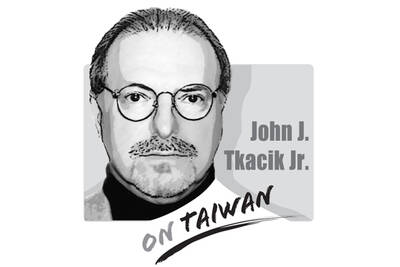Nearly two months have passed since the presidential and legislative elections.
The president-elect’s inauguration is not until May, so the public is focused on the 11th Legislative Yuan that began last month.
Given that neither of the major political parties hold an absolute majority, people watched the elections of the legislative speaker and committee conveners with great interest, observing how the three parties compete and collaborate with one another.
While campaigning, the Taiwan People’s Party (TPP) said it would take down the blue and green camps. Many voters, tired of the Democratic Progressive Party (DPP) and the Chinese Nationalist Party (KMT), voted for the TPP.
However, judging from the elections of the legislative speaker and committee conveners, it is unclear how the TPP would oust the KMT.
The entire process only showed the TPP shifting stances to draw more attention. Things have just begun, but it is hard to say what changes the TPP would bring. Moreover, it is undeniable that the slogan — “oust the KMT” — remains just a slogan.
When TPP Chairman Ko Wen-je (柯文哲) ran for Taipei mayor the first time, he and his team were good at using social media platforms to attract public attention and turn their Internet traffic into votes.
However, as a politician, winning votes should not be the ultimate goal, just like a corporation does not merely aim to boost traffic, but to turn it into profits.
For a politician, after turning traffic into votes, they should understand that votes are only an instrument for them to realize what they want to do afterward.
In the age of social media and digital devices, politicians have more opportunities to project their image.
Viewers’ attention has shifted away from more traditional media like newspapers and television to social media platforms. Younger and entrepreneurial politicians have taken advantage of this trend, employing new modes of communication, and behaving and talking like Internet influencers to attract more supporters.
However, the performance of “influencer-politicians” are not entirely different from political performances in the age of traditional media.
Politicians now — as in the past — still want to be eye-catching, and mainstream media platforms are still battlegrounds to compete with rivals.
In the early days of the social media, given their lack of experience in politics, these “influencer-politicians” seem to project a “fresh” image, attracting Internet traffic. However, 20 years later, their antics online are just the same as politicians competing for headlines in traditional media.
The ways to shape a politician’s character and story are the same: Everything is carefully calculated and measured.
It is not my intention to stigmatize Internet influencers by drawing a parallel between influencers and politicians.
What I am saying is that the two groups share similar temperaments, capabilities and methods for attracting Internet traffic. However, influencers do not aim for traffic only. Some want to turn traffic into profit, while others want to impart knowledge or raise awareness.
As for influencer-politicians, what is their goal? Do they care about social problems at all, or are they merely aiming for more votes?
Rational and pragmatic voters must monitor the conduct of those politicians to find out.
Chang Yueh-han is a doctoral student at Shih Hsin University’s Department of Journalism.
Translated by Emma Liu

On May 7, 1971, Henry Kissinger planned his first, ultra-secret mission to China and pondered whether it would be better to meet his Chinese interlocutors “in Pakistan where the Pakistanis would tape the meeting — or in China where the Chinese would do the taping.” After a flicker of thought, he decided to have the Chinese do all the tape recording, translating and transcribing. Fortuitously, historians have several thousand pages of verbatim texts of Dr. Kissinger’s negotiations with his Chinese counterparts. Paradoxically, behind the scenes, Chinese stenographers prepared verbatim English language typescripts faster than they could translate and type them
More than 30 years ago when I immigrated to the US, applied for citizenship and took the 100-question civics test, the one part of the naturalization process that left the deepest impression on me was one question on the N-400 form, which asked: “Have you ever been a member of, involved in or in any way associated with any communist or totalitarian party anywhere in the world?” Answering “yes” could lead to the rejection of your application. Some people might try their luck and lie, but if exposed, the consequences could be much worse — a person could be fined,
Xiaomi Corp founder Lei Jun (雷軍) on May 22 made a high-profile announcement, giving online viewers a sneak peek at the company’s first 3-nanometer mobile processor — the Xring O1 chip — and saying it is a breakthrough in China’s chip design history. Although Xiaomi might be capable of designing chips, it lacks the ability to manufacture them. No matter how beautifully planned the blueprints are, if they cannot be mass-produced, they are nothing more than drawings on paper. The truth is that China’s chipmaking efforts are still heavily reliant on the free world — particularly on Taiwan Semiconductor Manufacturing
Last week, Nvidia chief executive officer Jensen Huang (黃仁勳) unveiled the location of Nvidia’s new Taipei headquarters and announced plans to build the world’s first large-scale artificial intelligence (AI) supercomputer in Taiwan. In Taipei, Huang’s announcement was welcomed as a milestone for Taiwan’s tech industry. However, beneath the excitement lies a significant question: Can Taiwan’s electricity infrastructure, especially its renewable energy supply, keep up with growing demand from AI chipmaking? Despite its leadership in digital hardware, Taiwan lags behind in renewable energy adoption. Moreover, the electricity grid is already experiencing supply shortages. As Taiwan’s role in AI manufacturing expands, it is critical that